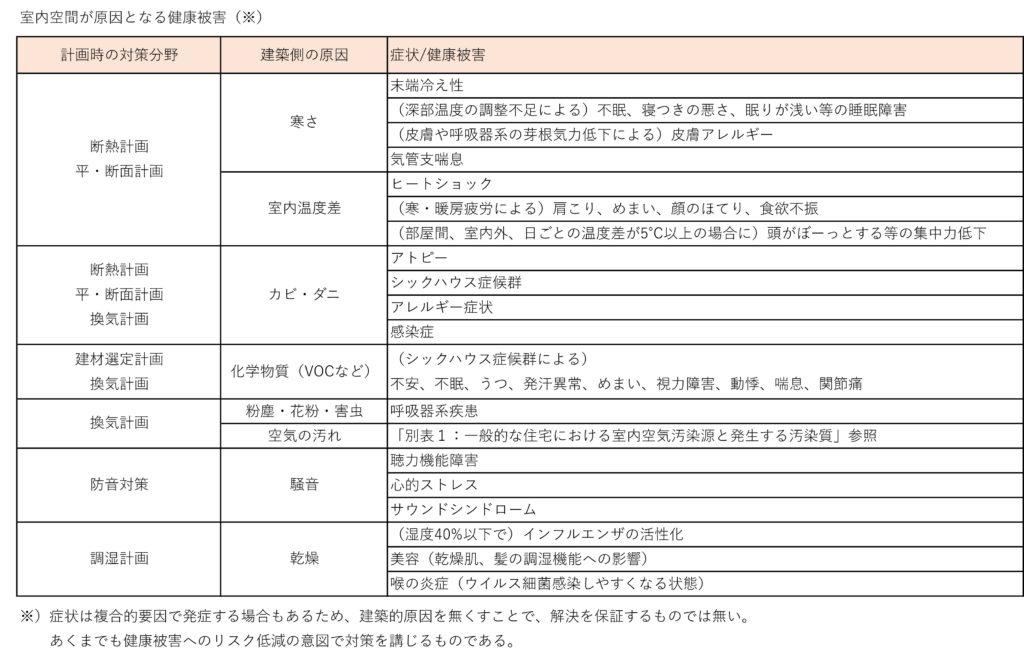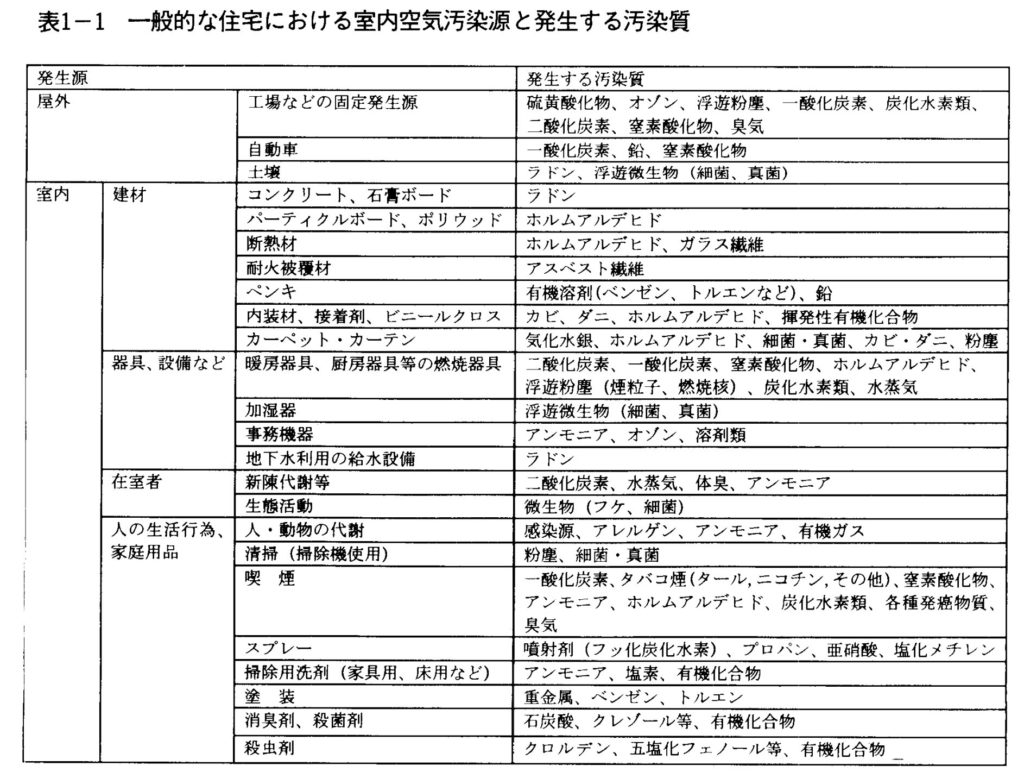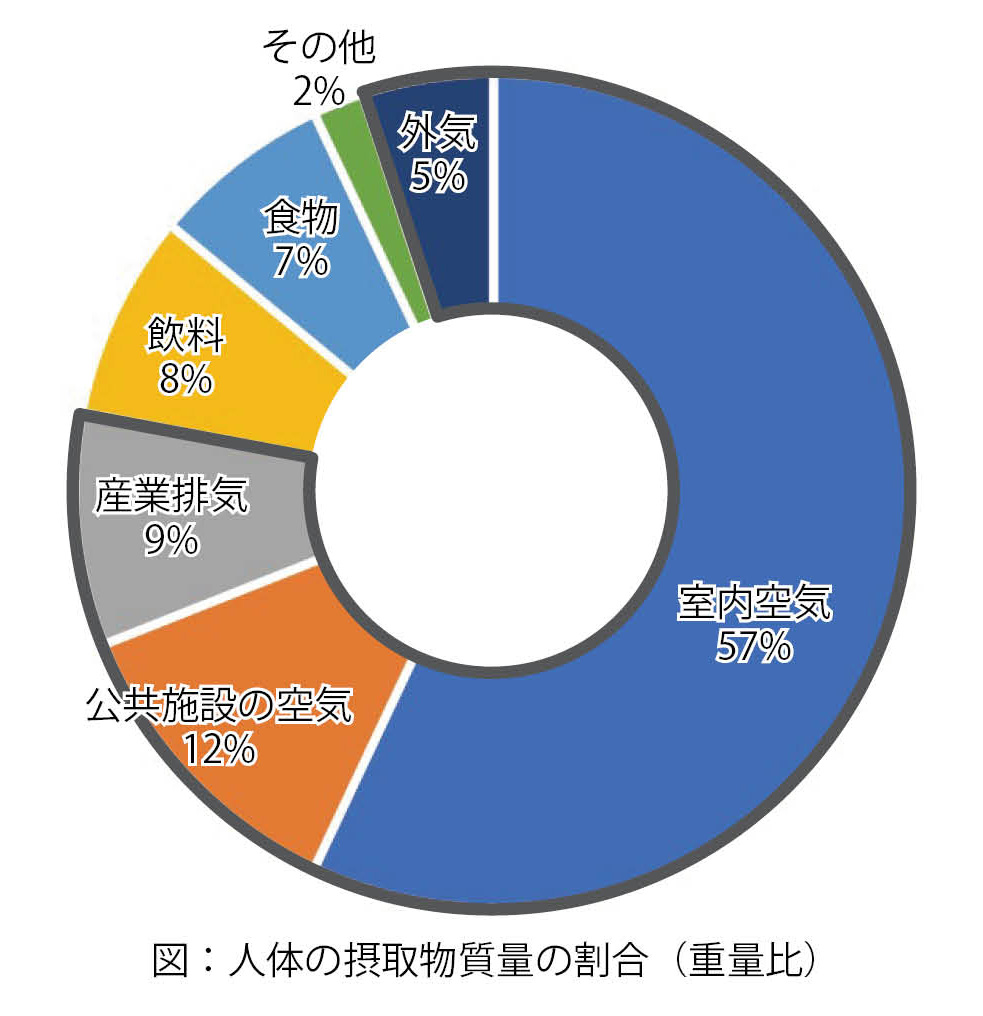08 室内空間が原因となる健康被害 -Health hazards caused by indoor spaces-
English is written after Japanese description.#Health-hazaeds
ある方の正直な感想です。「今のままの住宅でもそんなに悪いこともないから、特段、室内空間を「健康化」することの意義が分かりません。今、普通であるものを特別にすることまでは望んでいないので。。。」
そんな声が聞こえてきます。実際、健康リスクは、人個別の免疫力や周辺環境などにも大きく影響されますし、目に見えないまま、住宅被害などが実は進行していて、ある程度の被害となった段階で判明するというようなこともあるため、現在は目に見えていないだけ、ということも考えられます。
ここでは目に見えにくい、健康被害の具体的な諸症状と原因を明確にしていきます。全てを抑え込むことも現状では難しいことも事実ですが、関連性を把握しつつ、対処を行うことで、健康被害を抑えることは可能と考えています。
まずは、健康被害の一覧とその原因と考えられている建築側の原因がまとめられた一覧を紹介します。(※1)

少し難しい表が並びますが、下図は、一般的な住宅における室内空気汚染源と、発生する汚染質を示しています。(※2)

これらの諸症状は建築(室内環境)が一因となっている場合があると言われていて、個別の関連性は明確にされています。個別に建設後に対処することは難しいため、新築・改修の際に押さえておく必要があります。気になる健康被害がある場合は、設計される方に相談頂くといいと思います。
但し、実際の健康被害の発症原因は建築以外の要因やそれらとの複合的要因で発症する場合も多いため、建築側要因を削除すればすべて解決とはならない点には、留意してください。
また、室内環境がいかに重要かという点で、押さえておくべきポイントとして、人体が1日に取り込む物質重量で最大のものは、飲食物でなく、室内空気であることです。また、驚くべきことに、下図(人体の摂取物質量の割合)から、人体が体に取り込む最大の物質は「空気」であり、その重量は1日当たり約18㎏(下図太線囲みの範囲の合計)と言われています。(※3)一番摂取する物質が汚れていれば、体内も同じように汚れてしまいます。室内空気環境がいかに重要かが、感覚的にも明確に理解できると思います。

目に見えないところですが、これらのことに対応している・していないでは、長期視点で見た時に、健康時間を削減してしまっていたり、医療費が増加していることが、他調査事例などで報告されています。空間の健康化を考える際には、大きく2つの側面があり、1つはマイナス要因を取り除くこと、もう1つは、プラス要因を付加することです。ここでは、1つ目のポイントであるマイナス要因(=健康被害)を整理しました。もう1つの側面である「健康空間」における積極的な快適性やプラス要因は、別項で整理していきます。
※1)下記の情報元等を踏まえ当事務所にて編集
・NPO法人日本健康住宅教会編/発行(2022) 健やか住まい方のわかる本
・前真之著(2020) エコハウスのウソ2 日経BP社
・健康をつくる住環境編集委員会編(2002) 健康をつくる住環境 (株)井上書院
※2)小峯祐己(1996) 住宅における室内空気質に起因する健康影響 住宅総合研究財団 研究年報No.23
※3)下記の情報元等を踏まえ当事務所にて編集
・シンポジウム資料「連続講座『ヘルシーな室内環境』2000年2月」(社)日本建築学会
・前真之著(2020) エコハウスのウソ2 日経BP社
Health hazards caused by indoor spaces
One person’s honest opinion. ‘I don’t understand the significance of ‘healthifying’ the interior space in particular, as there is nothing too bad in the house as it is now. I don’t even want to make what is normal now special…’
Such voices are heard. In fact, health risks are greatly influenced by the immunity of individual people and the surrounding environment, and it is also possible that the damage to housing is actually progressing without being visible, and that it is only revealed when the damage has reached a certain level, therefore probably it is not visible currently.
This section will clarify the specific symptoms and causes of health damage that are invisible. It is also true that it is currently difficult to control all of them, but we believe that it is possible to reduce the health hazards by understanding their relevance and taking action.
First, a list of health hazards and their possible causes on the building side are listed below. (*1)
Although the table is a little difficult to follow, the diagram below shows the sources of indoor air pollution in a typical house and the pollution quality generated. (*2)
It is said that architecture (indoor environment) may be a contributing factor to these various conditions, and individual associations have been clarified. As it is difficult to address them individually post-construction, they need to be kept in mind during new construction and refurbishment. If there are health hazards of concern, it is advisable to consult the person designing the building.
However, it should be noted that the actual health hazards are often caused by factors other than construction or a combination of factors, so removing factors on the construction side will not solve all problems.
Another point to bear in mind in terms of how important the indoor environment is is that the largest substance weight that the human body takes in each day is not food or drink, but indoor air. Also, surprisingly, according to the figure below (percentage of substances ingested by the human body), the largest substance the human body takes in is ‘air’, which is said to weigh approximately 18 kg per day (total of the area enclosed by the bold line in the figure below). (*3) If the substances we take in the most are polluted, our bodies will be polluted as well. The importance of the indoor air environment can be clearly understood visibly.
Although invisible, it has been reported in other studies and case studies that, from a long-term perspective, the health time has been reduced and health care costs have increased when these things are not addressed. There are two main aspects to consider when thinking about making spaces healthier: one is to remove negative factors and the other is to add positive factors. The first point, negative factors (i.e. health hazards), has been organised here. The other aspect, positive comfort and positive factors in ‘healthy spaces’, will be organised in a separate section.
(*1) Edited by our office based on the following sources of information, etc.
The book is based on the following sources of information: – NPO Japan Healthy Housing Church, edited/published (2022) Book of Understanding Healthy Living.
(2020) Lies of Eco Houses 2, Nikkei Business Publications, Inc.
Edited by Editorial Committee for Health-creating Living Environment (2002) Health-creating Living Environment (Inoue Shoin Co., Ltd.)
(*2) Yumi Komine (1996) Health Effects Caused by Indoor Air Quality in Houses, Jutaku Sougou Kenkyu Foundation Research Annual Report No.23.
(*3) Edited by our office based on the following sources of information.
(1996) Health Effects Caused by Indoor Air Quality in Houses Research Report No. 23, Housing Research Foundation Research Report No. 23 *3) Edited by our office based on the following information sources.
(2020) Eco House Lies 2, Nikkei Business Publications, Inc.
